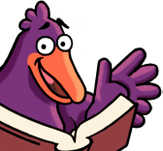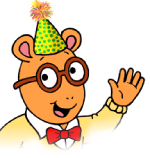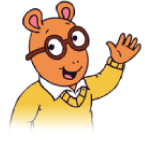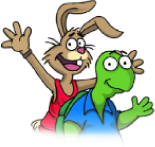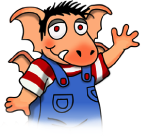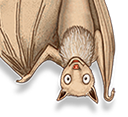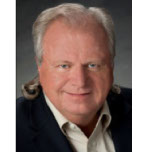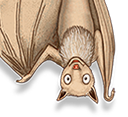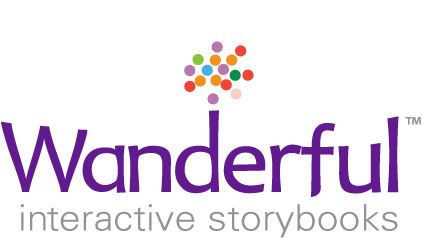Creating Living Books
Mark Schlichting
The initial idea for Living Books came to me when I was a kid. I always wanted to go inside Dr. Seuss's Horton Hears a Who! book and play with all the weird and fantastical instruments and contraptions to see what they would do. Then I got into children's software in 1987 because I couldn't find anything "educational" my boys wanted to play with at the time. I saw how engaged they could be for hours on end with a Nintendo game, but getting these same boys to do even a half hour of homework was a very different story. I was inspired to create something with the ability to delight and engage kids but that also had real learning content as well. This is where the concept for Living Books came to life.
In 1988 I had been doing contract work as a digital illustrator for Broderbund Software's early versions of Where in the World is Carmen Sandiego game. I liked the company and the people I met there, and when an opportunity opened up for a full time position I applied.
Once inside Broderbund I began pitching the idea of an interactive storybook to anyone who would listen, and even had a book I had illustrated, called I'm Mine to show how it would work. I talked to my current boss, Michele Bushneff; to her boss, John Baker; and one of the founding and managing partners, Doug Carlston; each of them encouraged me in different ways. After 4 months they allowed me to take some time to create a prototype using a very early version of what became MacroMedia's Director program.
As the prototype progressed I needed voices for the various characters and began recording everyone in the office to help out. It was fun to include everyone working around me, but it had the interesting effect that they also became part of the project, and championed its success.
It became clear that I was not selling a product idea, but creating a shared vision about how we could make a difference, and that shared vision influenced how the entire company felt about our work together for years to come.
The important thing was to have Living Books really work for kids, so we watched them play with the prototype and listened to their feedback. I had seen many products made "for kids", but seldom "with kids". I wanted to understand what excited and engaged them rather than assume from my adult perspective that I knew. And teach me they did. All these years later I am still a giant fan of kid-informed design.
We also talked to classroom teachers to find out that they wanted and needed. Teachers immediately understood and loved the learning potential they saw in all the interactive words, but their main request was, "Make it easy to use, I don't have time to be the technologist and the teacher." Just put a disc in and it plays, that was our final solution and it came directly from teachers.
As the first months passed, it began to look like Living Books had something unique about it and our first programmer (Michael Coffey) was added to help think about how we might make it work. The prototype was cute and the experience was good, but could we actually make something dance from a CD-ROM, which at the time had delayed reactions (up to a minute wait) when you clicked on something – not exactly interactive.
We picked our first title, Mercer Meyer's Just Grandma and Me, and more people where allocated to work on it. Barbara Lawrence began working on the digital backgrounds, and Don Albretch, an older Disney animator began helping me with animations. Since multimedia was a new thing, Broderbund didn't yet have a recording studio and we did every audio take in a small office, one at time, stopping to save and start again. Tom Rettig, the only sound person at that time, did all of the very early recording.
With the support of Broderbund management, we became the Living Books group, moved to a small open office area above shipping and receiving and added animators, Bridget Erdman, Michael Dashow, and Donna Bonifield, as well as our first full time sound designer and musician, Joey Edleman, who wrote our Living Books theme and many of the dances themes for our early stories.
We also added a team of programmers. Up to this point, most products were built by one primary programmer per title, with some help on pieces along the way. But for Living Books I wanted an engine that was cross platform (could easily play on Mac, PC, or more), driven by the animation needs (since it was expensive we only wanted to draw it once), AND (this was a big one) turned the CD-ROM from a storage device into a highly interactive player – not like anything I had seen done at this point.
To accomplish this, Broderbund supplied me a great mixed team of programmers. We had senior systems guru Glenn Axworthy, Dave Lucas working on audio, Mark Webster on (trombone?), and Matt Siegal working with all our animation graphics. In my mind these guys are the hidden magic behind Living Books because they were able to make the pages load, characters dance, and everything feel interactively "right" while making it look simple to do, when it was anything but. Mickey Mantle also joined Broderbund at this time as CTO and became a Living Books advocate.
We had a variety of great Broderbund producers work with us in the early years: Clair Curtain, Todd Power, and Rob Martyn all helped us stay on task. We released our first title, Mercer Mayer's Just Grandma and Me in 1992, hoping there was a big enough installed base of CD drives to use it. Our worries were short lived as sales projections where surpassed by a factor of 10 in the first six months.
As our first titles sold well we were able to add more artists and musicians to our team, and we all moved to the new Broderbund office in Novato, CA. About this time Alberto Vitale, head of Random House Publishing saw a demo of Just Grandma and Me at the American Booksellers Association convention, and was excited because they didn't have the digital rights to Dr. Seuss and it looked like it might go somewhere else (not something they wanted to happen, having been Dr. Seuss' main publisher since early on.)
They came to us and asked if we could create a demo to show Audrey Geisel, Mrs. Dr. Seuss and rights holder to all the Seuss titles. We agreed, and I put together a special demo that showed how a Dr. Seuss title might look. I also incorporated Broderbund's paint product, Kid Pix, with Seuss stickers from his I Can Draw It Myself book. We met in La Jolla, California with Audrey sitting amongst a line of her intellectual property lawyers, Alberto from Random House, Doug Carlston (now CEO of Broderbund), John Baker (my boss), and me.
We had no idea how it would go. I began my demo showing the interactivity, humor and personality we could get with our animation and the paint program. Things were "quiet" but going well as far as I could tell. I continued on with my demo, but then at one moment decided to stop and tell the story of what inspired me to create Living Books – the one about how when I was a kid I always wanted to go into "Horton Hears A Who" and play with the cool instruments in Whoville.
Shortly after I finished telling that story, Mrs. Seuss quietly rose from her seat and walked around the table to where I was sitting in front of the computer. She took my arm and lifted me out of my seat, then turned to her lawyers and said with a smile, "I've changed my mind, I'm going to work with him." Then she said, "We are going to lunch, and you can join us if you wish," and walked me arm in arm out of the room. For me it was a dream come true, the opportunity to be the first to take Dr. Seuss to a digital format and play inside those stories.
Alberto Vitale was so delighted that he offered to, and subsequently did buy half of Living Books, and we became Living Books, a Broderbund/Random House company and moved our offices to San Francisco. In San Francisco we brought in Jeff Schon to be the CEO of our newly independent company. I always thought Jeff was a good fit, especially as earlier in his career he was the producer of Pee Wee's Playhouse.
We grew to a company of over 100 people and produced a total of 20 titles over the next several years, most in multiple languages. Living Books won scores of awards, and was one of the first pieces of software to be considered a "textbook" in several states (teachers were already buying and using them in their classrooms.) But for many of us, the best part of it all were the stream of beautiful letters we got from kids and parents thanking us for making something wonderful that made a difference in their lives.
By late 1997, so many companies were flooding the market with children's CD software that the price of all titles began to drop precipitously to the point were companies had trouble staying afloat. Broderbund was bought in a hostile take over (as were The Learning Company and many other pioneering child-focused companies) and all sold to Mattel, a great company that knew little about keeping software titles alive. As a result, many great CD-ROM titles for kids were forgotten while technology and operating systems moved forward.
For years, former team members and fans wished there was a way to resurrect these great titles and several of us looked into it, but it took the technological insight and belief of Mickey Mantle to bring them into a new incarnation as Wanderful interactive storybooks. Something I am deeply grateful for. You can imagine how excited I was when Mickey called to say, "Hey Mark, we are getting the band back together!"
Reviving Living Books
Mickey W. Mantle
As Mark related in the Creating Living Books story, I joined Broderbund in late 1991 as Chief Technical Officer. Before then I was Director of 3D Graphics at Pixar. It was a dream job in many ways, but when I saw the initial prototype of Living Books during a visit to Broderbund I knew that I had seen something special.
Upon joining Broderbund I took on Living Books as my pet project (with encouragement from CEO Doug Carlston), and spent a considerable amount of time working directly with the programmers to ensure they delivered what was desired by the Living Books team. It was not an easy task; the Living Books team was demanding, often asking for things that were pushing the envelope of the technology at the time. But they were asking for the right things – things that would make great products if they could be delivered. And delivered they did, both the programming technology and the great products.
The programming team was strong, but two individuals were clearly the rock stars of the group; Glenn Axworthy and Matt Siegel. Glenn is one of those talented systems programmers that you could write a book about – and in fact I did, titled Managing the Unmanageable published by Addison Wesley. It wasn't that Glenn was unmanageable, but you had to align your needs with his point of view to get the best results.
Luckily, Glenn's talent and desire to create clean, well architected systems lead to the development of a multimedia playback engine that became the Living Books engine. It allowed the products to be authored in Macromedia Director, and then transformed the Director playback files into a cross-platform, optimized playback format that could be streamed from slow speed CD-ROMs into limited memory computers and played back at the appropriate speed regardless of the speed of the CPU of the computer running the product. This enabled the Living Books creative team to focus strictly on making great animations and products, and the programming team to focus on making them playback well and on all configurations of Macs and PCs.
Matt Siegel complemented Glenn's systems skills by creating a highly tuned animation driver that touched as "few pixels as possible" to make animations run consistently fast regardless of their size. Matt also complemented Glenn's conservative nature by trying to find ways to do everything the Living Books team wanted to do. Together they made a world class programming team that delivered world class products!
The other rock star was actually more than a programmer; Rob Bell was the technical guy who managed the organization of the data, how it was played back and he and his team actually made all the products work. And in Living Books fashion, they just worked well…all the time. Later on, Rob actually took over the development of the Living Books engine from Glenn and Matt and expanded its capabilities to do even more by adding an interpretive language ("SLANG") to allow the Living Books team to do even more.
But alas, by late 1999 Broderbund had been sold to The Learning Company which was sold to Mattel, which then within a year sold off The Learning Company assets for a fraction of the $3.8B that Mattel paid to acquire them. Broderbund as a brand continued to live on, but Broderbund Software, that fabulously creative company, was disbanded with all the great talent left to find a new outlet for their creativity.
I left Broderbund and joined a start-up company called Gracenote, which was a pioneer in providing music information web-services to companies such as Apple, which included its technology in iTunes and helped power the emergence of the iPod, iPhone, and iPad.
In 2010, eleven years later, I was still at Gracenote. I had brought on many talented technical staff members from Broderbund to help build out our technology there, and we created some great things as well. But when I first saw Steve Jobs, who I had reported into at Pixar, announce the iPad in March 2010 I said to myself "at last, here is the perfect device for the Living Books products!"
Luckily, just after that Glenn Axworthy sent me an email asking me if I had any work for him at Gracenote. But I had a different idea for him. I suggested that we build a prototype of a new technology that could use the existing assets (animations, graphics, sound, music, etc.) on the Living Books CD-ROMs to make the Living Books live again.
I then contacted John Baker, who was the executive champion for Living Books at Broderbund and with him strategized how to track down the rights to the CD-ROM assets and license them. We finally determined that the rights resided with Houghton Mifflin Harcourt.
By early 2011, Glenn was working on this full-time and there was finally a new Living Book prototype running on the iPad and I was ready to tackle the licensing with Houghton Mifflin Harcourt (HMH). With retirement at Gracenote rapidly approaching, I began my quest to talk to someone at HMH.
After several months of being bounced from one person to another within HMH, I finally met with John Bartlett the VP, Licensing Consumer Products and Solutions. John was a former Learning Company guy who remembered the Living Books well and he became an ally to help me obtain the licensing from HMH for the Living Books CD-ROM assets.
So with a working prototype product and a license to the Living Books CD-ROM assets in hand it was time to ramp up the company. I brought Mike Foulger on-board, to help Glenn complete the technology (unfortunately, Mike passed away suddenly only a few weeks after starting to work with Glenn). I then brought Rob Bell on-board, to help Glenn massage the data assets and work out issues with specific products.
My second call was to Mark Schlichting, to tell him I was "getting the band back together" with Glenn and Rob already working for me. He was excited, but cautious. He said it was a great idea, but he wasn't interested if we only wanted to revive Living Books. He was only interested if we were willing to enhance them to make them "better than any other products out in the market today". Mark evaluated the prototype product and came back with a list of requirements and suggestions for enhancing the products.
I met with the technical team, and we evaluated Mark's list and agreed to most of his requirements and suggestions (in the end we addressed all his requirements and suggestions). As such, we embarked on a many months process to rework the new technology to add things like "interruptible" animations, more responsiveness, immediate language switching, new navigation methods, etc. A key moment in this effort was when we convinced Matt Siegel to join us. It was like adding George Harrison to John Lennon and Paul McCartney – suddenly the band was REALLY back together and sounding great!
Matt took on all of Mark's user interface issues, while Glenn and Rob tackled the meaty engine technology and data issues. Together, with occasional help from other former Broderbund or Living Books staff we pulled in to help us, the team put together the Apps you have in your hands today. It is an amazing feat of engineering and creative design! It couldn't have happened without Mark's creative input and drive for perfection, Matt's ability to turn Mark's input into reality, and Glenn and Rob's deep technical skills, and the help from many others along the way.
Along the way I have provided the vision, funding, oversight, dedication, passion and drive to make these great products available to a new generation of children. It has been a demanding but fun effort. I hope you enjoy playing with these products as much as we have enjoyed creating them for you.
Applications
Platforms
© 2025 Wanderful, LLC (DBA: Wanderful Edutainment and Wanderful Interactive Storybooks). A Jordan Freeman Group Company. Powered by ZOOM Platform. All Rights Reserved. Living Books is a registered trademark of Houghton Mifflin Harcourt, used with permission. Arthur, © Marc Brown Studios, All Rights Reserved. Little Critter, Little Monster, © Mercer Mayer, All Rights Reserved.
